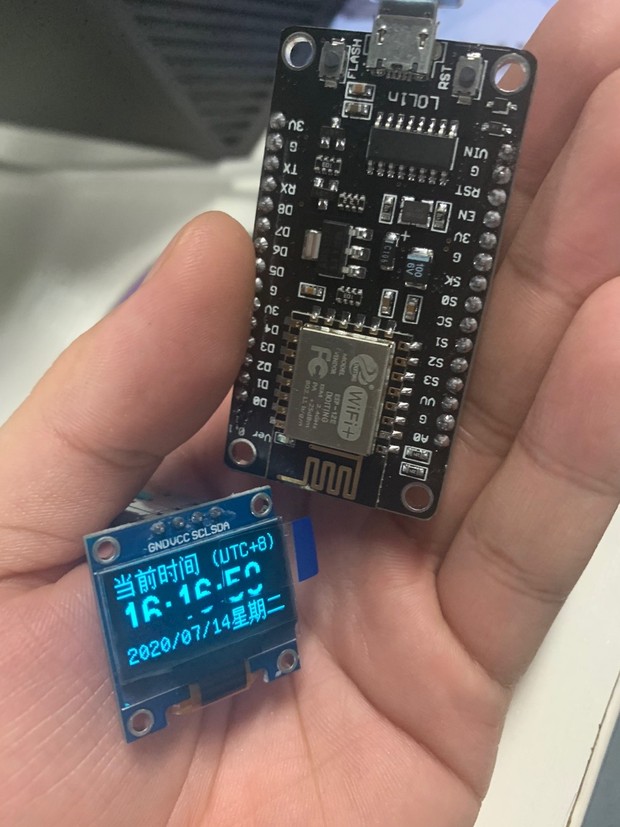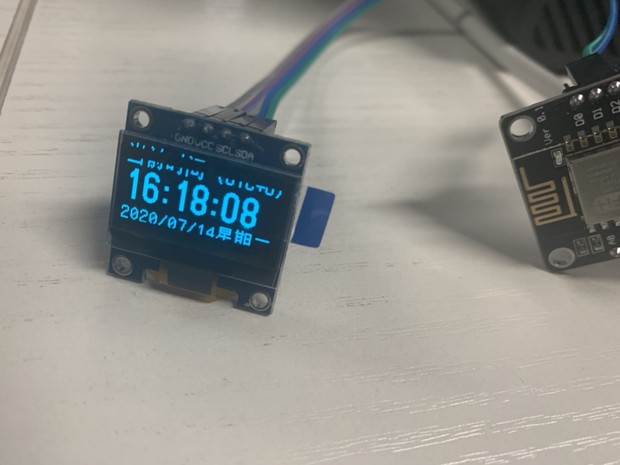esp8266 0.96 oled 时钟小玩具


显示 文字上有缺失是因为手机拍照的问题,肉眼看是ojbk的
/* * 7pin SPI引脚,正面看,从左到右依次为GND、VCC、D0、D1、RES、DC、CS * ESP8266 --- OLED * 3V --- VCC * G --- GND * D7 --- D1 * D5 --- D0 * D2orD8--- CS * D1 --- DC * RST --- RES * 4pin IIC引脚,正面看,从左到右依次为GND、VCC、SCL、SDA * ESP8266 --- OLED * 3.3V --- VCC * G (GND) --- GND * D1(GPIO5)--- SCL * D2(GPIO4)--- SDA */ #include <TimeLib.h> #include <ESP8266WiFi.h> #include <WiFiUdp.h> #include <SPI.h> #include <DYWiFiConfig.h> #include <U8g2lib.h> //若屏幕使用SH1106,只需把SSD1306改为SH1106即可 //U8G2_SSD1306_128X64_NONAME_F_4W_HW_SPI u8g2(U8G2_R0, /* cs=*/4, /* dc=*/5, /* reset=*/3); U8G2_SSD1306_128X64_NONAME_F_HW_I2C u8g2(U8G2_R0, /* reset=*/ U8X8_PIN_NONE); //U8G2_SSD1306_128X64_NONAME_F_HW_I2C u8g2(U8G2_R0, /* reset=*/ U8X8_PIN_NONE, /* clock=*/ 4, /* data=*/ 5); //D-duino DYWiFiConfig wificonfig; ESP8266WebServer webserver(80); #define DEF_WIFI_SSID "x"xxx #define DEF_WIWI_PASSWORD "xxx" #define AP_NAME "WangZhiBo" //dev void wificb(int c) { Serial.print("=-=-=-=-"); Serial.println(c); } static const char ntpServerName[] = "ntp1.aliyun.com"; //NTP服务器,阿里云 const int timeZone = 8; //时区,北京时间为+8 WiFiUDP Udp; unsigned int localPort = 8888; // 用于侦听UDP数据包的本地端口 time_t getNtpTime(); void sendNTPpacket(IPAddress& address); void oledClockDisplay(); void sendCommand(int command, int value); void initdisplay(); boolean isNTPConnected = false; const unsigned char xing[] U8X8_PROGMEM = { 0x00, 0x00, 0xF8, 0x0F, 0x08, 0x08, 0xF8, 0x0F, 0x08, 0x08, 0xF8, 0x0F, 0x80, 0x00, 0x88, 0x00, 0xF8, 0x1F, 0x84, 0x00, 0x82, 0x00, 0xF8, 0x0F, 0x80, 0x00, 0x80, 0x00, 0xFE, 0x3F, 0x00, 0x00 }; /*星*/ const unsigned char liu[] U8X8_PROGMEM = { 0x40, 0x00, 0x80, 0x00, 0x00, 0x01, 0x00, 0x01, 0x00, 0x00, 0xFF, 0x7F, 0x00, 0x00, 0x00, 0x00, 0x20, 0x02, 0x20, 0x04, 0x10, 0x08, 0x10, 0x10, 0x08, 0x10, 0x04, 0x20, 0x02, 0x20, 0x00, 0x00 }; /*六*/ void setup() { Serial.begin(115200); while (!Serial) continue; //Serial.println("NTP Clock oled version v1.1"); Serial.println("Designed by WangZhiBo"); initdisplay(); u8g2.clearBuffer(); u8g2.setFont(u8g2_font_unifont_t_chinese2); u8g2.setCursor(0, 14); u8g2.print("Waiting for WiFi"); u8g2.setCursor(0, 30); u8g2.print("connection..."); u8g2.setCursor(0, 47); u8g2.print("WangZhiBo"); u8g2.setCursor(0, 64); u8g2.print("192.168.4.1 ^.^"); u8g2.sendBuffer(); Serial.println("OLED Ready"); Serial.print("Connecting WiFi..."); wificonfig.begin(&webserver, "/"); DYWIFICONFIG_STRUCT defaultConfig = wificonfig.createConfig(); strcpy(defaultConfig.SSID, DEF_WIFI_SSID); strcpy(defaultConfig.SSID_PASSWORD, DEF_WIWI_PASSWORD); strcpy(defaultConfig.HOSTNAME, AP_NAME); strcpy(defaultConfig.APNAME, AP_NAME); wificonfig.setDefaultConfig(defaultConfig); wificonfig.enableAP(); while (WiFi.status() != WL_CONNECTED) { wificonfig.handle(); //若不需要Web后台,可以注释掉此行 //Serial.println("Waiting for Connection..."); } Serial.println(""); Serial.println("WiFi connected"); Serial.println("IP address: "); Serial.println(WiFi.localIP()); Serial.println("Starting UDP"); Udp.begin(localPort); Serial.print("Local port: "); Serial.println(Udp.localPort()); Serial.println("waiting for sync"); setSyncProvider(getNtpTime); setSyncInterval(30); //每300秒同步一次时间 isNTPConnected = true; } time_t prevDisplay = 0; //当时钟已经显示 void loop() { if (timeStatus() != timeNotSet) { if (now() != prevDisplay) { //时间改变时更新显示 prevDisplay = now(); oledClockDisplay(); } } wificonfig.handle(); //若不需要Web后台,可以注释掉此行 } void initdisplay() { u8g2.begin(); u8g2.enableUTF8Print(); } void oledClockDisplay() { int years, months, days, hours, minutes, seconds, weekdays; years = year(); months = month(); days = day(); hours = hour(); minutes = minute(); seconds = second(); weekdays = weekday(); Serial.printf("%d/%d/%d %d:%d:%d Weekday:%d\n", years, months, days, hours, minutes, seconds, weekdays); u8g2.clearBuffer(); u8g2.setFont(u8g2_font_unifont_t_chinese2); u8g2.setCursor(0, 14); if (isNTPConnected) u8g2.print("当前时间 (UTC+8)"); else u8g2.print("无网络!"); //如果上次对时失败,则会显示无网络 String currentTime = ""; if (hours < 10) currentTime += 0; currentTime += hours; currentTime += ":"; if (minutes < 10) currentTime += 0; currentTime += minutes; currentTime += ":"; if (seconds < 10) currentTime += 0; currentTime += seconds; String currentDay = ""; currentDay += years; currentDay += "/"; if (months < 10) currentDay += 0; currentDay += months; currentDay += "/"; if (days < 10) currentDay += 0; currentDay += days; u8g2.setFont(u8g2_font_logisoso24_tr); u8g2.setCursor(0, 44); u8g2.print(currentTime); u8g2.setCursor(0, 61); u8g2.setFont(u8g2_font_unifont_t_chinese2); u8g2.print(currentDay); u8g2.drawXBM(80, 48, 16, 16, xing); u8g2.setCursor(95, 62); u8g2.print("期"); if (weekdays == 1) u8g2.print("日"); else if (weekdays == 2) u8g2.print("一"); else if (weekdays == 3) u8g2.print("二"); else if (weekdays == 4) u8g2.print("三"); else if (weekdays == 5) u8g2.print("四"); else if (weekdays == 6) u8g2.print("五"); else if (weekdays == 7) u8g2.drawXBM(111, 49, 16, 16, liu); u8g2.sendBuffer(); } /*-------- NTP 代码 ----------*/ const int NTP_PACKET_SIZE = 48; // NTP时间在消息的前48个字节里 byte packetBuffer[NTP_PACKET_SIZE]; // 输入输出包的缓冲区 time_t getNtpTime() { IPAddress ntpServerIP; // NTP服务器的地址 while (Udp.parsePacket() > 0); // 丢弃以前接收的任何数据包 Serial.println("Transmit NTP Request"); // 从池中获取随机服务器 WiFi.hostByName(ntpServerName, ntpServerIP); Serial.print(ntpServerName); Serial.print(": "); Serial.println(ntpServerIP); sendNTPpacket(ntpServerIP); uint32_t beginWait = millis(); while (millis() - beginWait < 1500) { int size = Udp.parsePacket(); if (size >= NTP_PACKET_SIZE) { Serial.println("Receive NTP Response"); isNTPConnected = true; Udp.read(packetBuffer, NTP_PACKET_SIZE); // 将数据包读取到缓冲区 unsigned long secsSince1900; // 将从位置40开始的四个字节转换为长整型,只取前32位整数部分 secsSince1900 = (unsigned long)packetBuffer[40] << 24; secsSince1900 |= (unsigned long)packetBuffer[41] << 16; secsSince1900 |= (unsigned long)packetBuffer[42] << 8; secsSince1900 |= (unsigned long)packetBuffer[43]; Serial.println(secsSince1900); Serial.println(secsSince1900 - 2208988800UL + timeZone * SECS_PER_HOUR); return secsSince1900 - 2208988800UL + timeZone * SECS_PER_HOUR; } } Serial.println("No NTP Response :-("); //无NTP响应 isNTPConnected = false; return 0; //如果未得到时间则返回0 } // 向给定地址的时间服务器发送NTP请求 void sendNTPpacket(IPAddress& address) { memset(packetBuffer, 0, NTP_PACKET_SIZE); packetBuffer[0] = 0b11100011; // LI, Version, Mode packetBuffer[1] = 0; // Stratum, or type of clock packetBuffer[2] = 6; // Polling Interval packetBuffer[3] = 0xEC; // Peer Clock Precision // 8 bytes of zero for Root Delay & Root Dispersion packetBuffer[12] = 49; packetBuffer[13] = 0x4E; packetBuffer[14] = 49; packetBuffer[15] = 52; Udp.beginPacket(address, 123); //NTP需要使用的UDP端口号为123 Udp.write(packetBuffer, NTP_PACKET_SIZE); Udp.endPacket(); }
本文作者:🐳.城南
本文链接:https://www.cnblogs.com/dockers/p/13299697.html
版权声明:本作品采用知识共享署名-非商业性使用-禁止演绎 2.5 中国大陆许可协议进行许可。






【推荐】国内首个AI IDE,深度理解中文开发场景,立即下载体验Trae
【推荐】编程新体验,更懂你的AI,立即体验豆包MarsCode编程助手
【推荐】抖音旗下AI助手豆包,你的智能百科全书,全免费不限次数
【推荐】轻量又高性能的 SSH 工具 IShell:AI 加持,快人一步